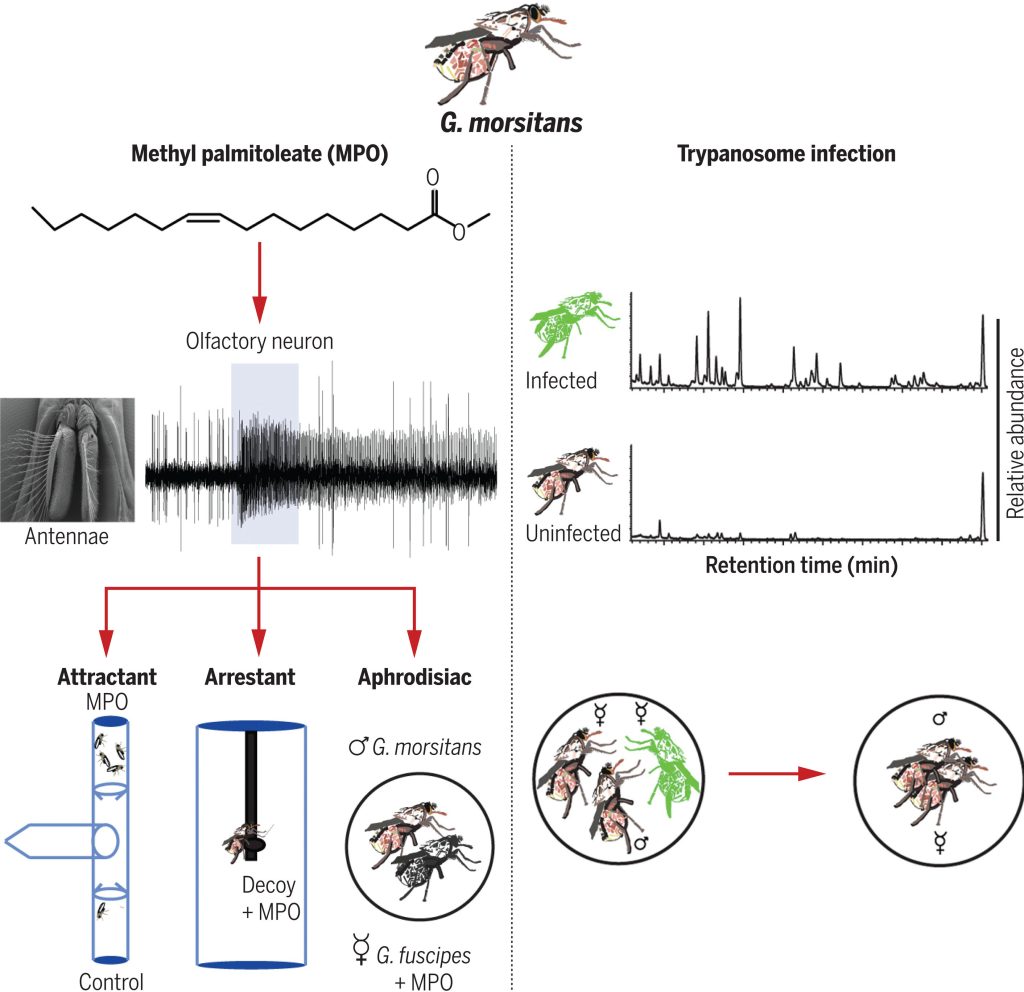Volatile chemicals of tsetse flies. Methyl palmitoleate (MPO), produced by the tsetse fly Glossina morsitans, elicits physiological responses from olfactory neurons. MPO also elicits behavioral responses, acting as an attractant and an arrestant, and as an aphrodisiac when used to perfume females of another species. Trypanosome infection alters the tsetse chemical profile. When placed with two females, one uninfected and one infected, males mated with the uninfected female. Credit: Estefania Alonso Gómez, CC BY-SA 4.0
Yale scientists have for the first time identified a volatile pheromone emitted by the tsetse fly, a blood-sucking insect that spreads diseases in both humans and animals across much of sub-Saharan Africa. The discovery offers new insights into how the flies communicate with one another and could yield new methods for controlling their populations and the harmful diseases they carry.
The findings are published in Science.
Tsetse flies are known to carry parasites called African trypanosomes. When the insects bite humans or animals, they transmit these parasites, spreading diseases such as African sleeping sickness, which can be fatal to humans, and nagana, a disease that affects livestock and other animals.
“African sleeping sickness is a dreadful disease that’s hard to treat. Our immune systems have a hard time clearing trypanosomes and most of the drugs we have to kill them are toxic,” said John Carlson, the Eugene Higgins Professor of Molecular, Cellular, and Developmental Biology in Yale’s Faculty of Arts and Sciences and senior author of the study. “And nagana, which affects livestock, has had terrible economic impacts in the region.”
Further, with climate change projected to expand the areas in which tsetse flies can survive, more humans and animals are expected to be affected by these diseases in the coming years.
One strategy identified as a way to control the spread of tsetse flies is to use their own pheromones—particularly volatile pheromones, or pheromones that work over distances rather than through direct contact—to attract and trap the insects.
To identify volatile pheromones that might be used for this purpose, the Yale research team took tsetse flies—of the species G. morsitans—and placed them in a liquid to collect any chemicals they might be emitting. They then ran those extracts through a device called a gas chromatograph-mass spectrometer, which can identify specific compounds from a mixed sample.
The researchers found several chemicals that had never previously been reported, including three that elicited responses from tsetse flies. One in particular, a chemical called methyl palmitoleate (MPO), had the strongest effects.
Specifically, in a series of experiments led by first author Shimaa Ebrahim, a postdoctoral fellow in Carlson’s lab, researchers found that MPO attracted male tsetse flies, caused them to stop and remain where they were for some time, and acted as an aphrodisiac. A drop of liquid containing MPO attracted male tsetse flies to knots in yarn that only resembled flies and to females of another tsetse fly species that they would not typically interact with.
To better understand how MPO mediated behavior, the researchers then tested whether neurons on the flies’ antennae responded to MPO. Indeed, they identified a subpopulation of olfactory neurons on the antennae that increased their firing rates when exposed to the pheromone.
Together, the findings indicate that MPO is a tsetse fly attractant, say the researchers, and therefore, it may be useful in slowing disease spread.
Currently, the most effective method of controlling tsetse fly populations is through traps that use odors from the animals the flies prefer to feed on.
“Now we’ve found this pheromone that could be used in combination with the host odors,” said Carlson. “Especially since MPO not only attracts the flies but causes them to freeze where they are.”
While animal odors have the benefit of attracting tsetse flies across large distances, they tend to fade quickly. MPO works at shorter distances but is effective for longer periods of time, Carlson added.
“MPO could be one more tool in the toolbox when it comes to combating tsetse flies and the diseases they spread,” he said.
The team is now working with collaborators in Kenya to test whether MPO is useful in traps in the real world, not just in a lab setting.
Additionally, the researchers want to understand what causes tsetse flies infected with trypanosomes to emit an entirely different set of chemicals —something else they identified in the study—and how that affects fly communication.
Other Yale authors include Hany Dweck and Brian Weiss.
More information: Shimaa A. M. Ebrahim et al, A volatile sex attractant of tsetse flies, Science (2023). DOI: 10.1126/science.ade1877
Provided by Yale University
Citation: Newly identified tsetse fly pheromone may help in curbing disease spread (2023, February 16) retrieved 1 March 2023 from https://phys.org/news/2023-02-newly-tsetse-fly-pheromone-curbing.html
This document is subject to copyright. Apart from any fair dealing for the purpose of private study or research, no part may be reproduced without the written permission. The content is provided for information purposes only.

